7 caves of India with great historic value
Seven Indian caves of great historic value are: Ajanta Caves (Buddhist murals), Ellora Caves (Hindu, Buddhist, and Jain art), Bhimbetka Caves (prehistoric rock paintings), Badami Caves (Chalukya-era rock-cut temples), Elephanta Caves (ancient sculptures), Udayagiri and Khandagiri Caves (Jain rock-cut shelters), and Karla Caves (ancient Buddhist chaitya). These sites showcase diverse artistic traditions, religious diversity, and some of the oldest human history in India.
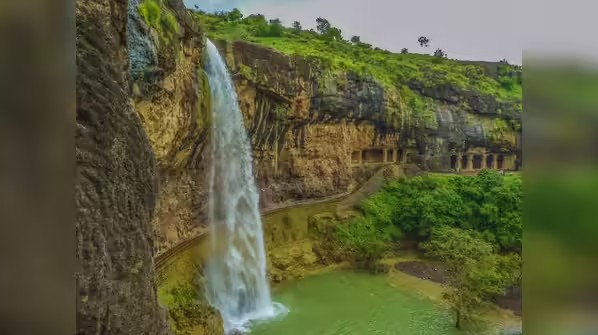
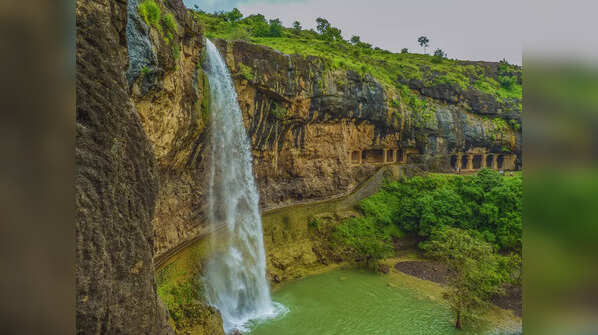
1/8
In India, saying ‘let’s go explore caves’ may mean differently than in other places. The reason being, in India, our caves are of different kinds. While some are great for spelunking and out stalactites and stalagmites, there are several that are of great historic value. These caves are a treasure trove of history and culture. From elaborate rock-cut caves to prehistoric rock shelters depicting lives of the early humans, these caves collectively highlight India’s rich historical, religious, and artistic legacy.
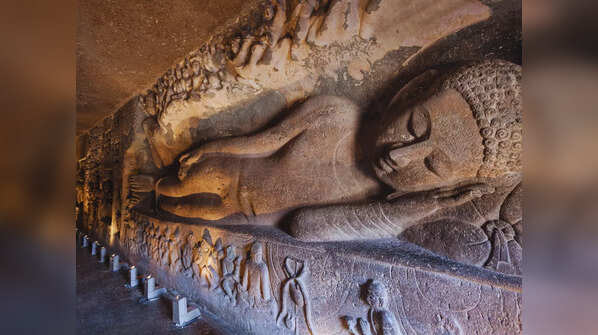
2/8
Ajanta Caves, Maharashtra
Dating back to the 2nd century BCE to 6th century CE, these UNESCO World Heritage Site rock-cut caves are renowned for their Buddhist art, intricate carvings, and vivid murals depicting Jataka tales and the life of Buddha.
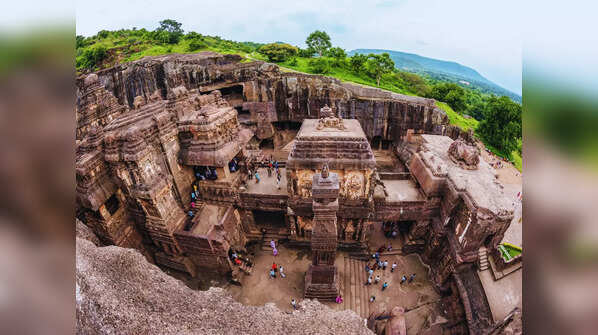
3/8
Ellora Caves, Maharashtra
A UNESCO World Heritage Site, these caves, dating back to the 5th to 10th century CE, represent a unique blend of Hindu, Buddhist, and Jain rock-cut architecture, with the Kailasa Temple (Cave 16) being the most popular structure.
The Ellora Caves in Maharashtra are a UNESCO World Heritage Site renowned for their extraordinary rock-cut architecture and religious significance. Located about 30 km from Aurangabad in the Charanandri Hills, the complex features 34 major caves—12 Buddhist, 17 Hindu, and 5 Jain—showcasing the artistic, architectural, and spiritual diversity of ancient India���.
Key highlights and history:The caves were constructed mainly between the 6th and 10th centuries CE, under dynasties such as the Rashtrakutas and Yadavas���.
The Kailasa Temple (Cave 16) is the most famous, celebrated as the world’s largest monolithic rock excavation, carved from a single piece of basalt rock and dedicated to Lord Shiva�.
All caves were hewn directly from basalt cliffs, with the site serving as both places of worship and monastic dwellings for monks and pilgrims���.
Visiting and practical details:Ellora is accessible by road and has onsite parking facilities (free and paid), is generally wheelchair accessible, and is family-friendly.The caves remain a central tourist attraction due to their impressive art, engineering, and the message of religious tolerance expressed by the co-existence of Buddhist, Hindu, and Jain monuments���.
4/8
Elephanta Caves, Maharashtra
A UNESCO World Heritage Site from the 5th to 8th century CE, these rock-cut caves are dedicated to Lord Shiva, featuring the iconic Trimurti (three-faced Shiva) sculpture. This is one of the most visited, photographed and loved sites in the cave complex.
The Elephanta Caves are renowned rock-cut cave temples situated on Elephanta Island (Gharapuri), about 10 kilometers east of Mumbai in Maharashtra. These caves have been recognized as a UNESCO World Heritage Site due to their significant art, architecture, and religious history���.
Overview and History
The caves date from the 5th to 7th centuries CE and are primarily dedicated to Lord Shiva, with a few Buddhist caves as well��.
The centerpiece is Cave 1, known as the Great Cave, featuring columns, a mandapa (pillared hall), and many intricately carved sculptures, including the celebrated Trimurti—a massive, three-headed depiction of Shiva��.
The island, originally called Gharapuri (meaning “city of caves”), has relics suggesting occupation since the 2nd century BCE, including Buddhist stupas and water tanks��.
The caves were constructed by cutting directly into basalt rock and exhibit a unique blend of Hindu and Buddhist artistic traditions���.
The caves suffered damage over centuries from natural forces, invading rulers, and colonial exploitation, but major restoration efforts have helped preserve their grandeur�.
Key Features
There are seven principal caves: five are Hindu and two are Buddhist�.
The site is accessible by a scenic ferry ride from Mumbai’s Gateway of India��.
The Trimurti Shiv sculpture, representing creation, preservation, and destruction, is a defining highlight of Indian rock art�.
Elephanta Island is also known for its lush greenery and panoramic views of the Mumbai harbor and skyline�.
Image Reference
An image showing the main hall and Trimurti sculpture of Elephanta Caves has been selected based on representative search results for the site�.
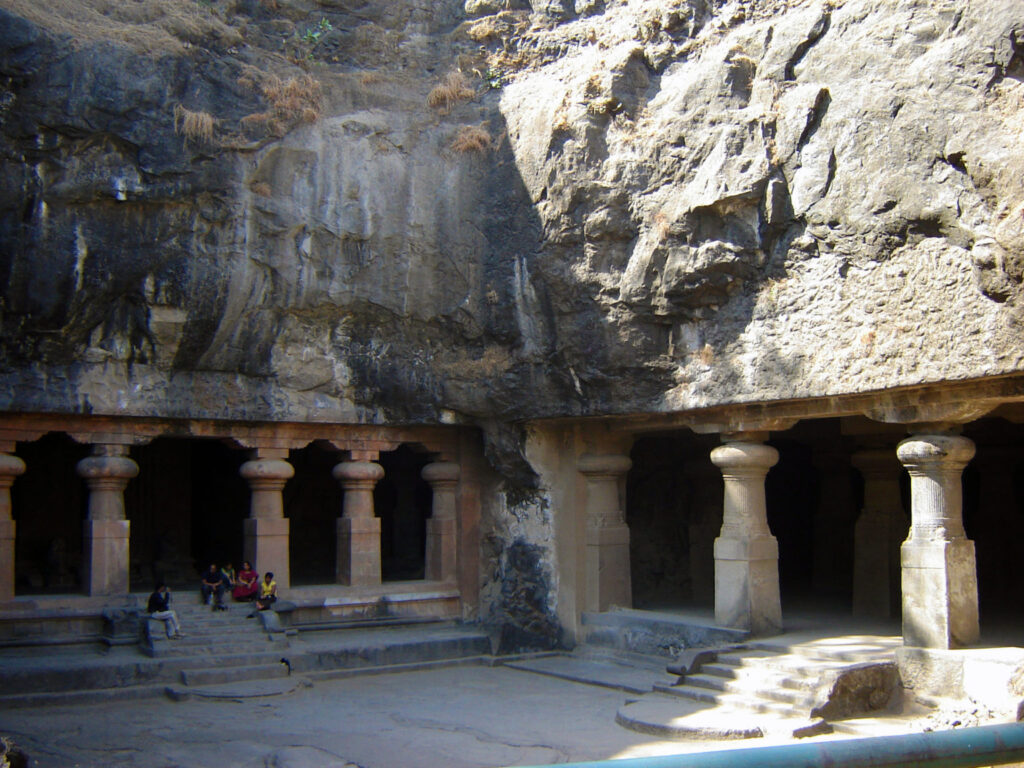
Bhimbetka Rock Shelters, Madhya Pradesh
A UNESCO World Heritage Site, these prehistoric rock shelters date back to the Paleolithic and Mesolithic eras, believed to be over 30,000 years old. Their walls are adorned with rock paintings illustrating early human life, hunting scenes, and ritual practices.
The Bhimbetka Rock Shelters, located in Madhya Pradesh about 45 km south of Bhopal, are a UNESCO World Heritage Site and one of India’s largest repositories of prehistoric art and archaeology���.
Location and DiscoveryThe Bhimbetka rock shelters are set amidst the sandstone foothills of the Vindhya Range, surrounded by forest and embedded within the Ratapani Wildlife Sanctuary���.
The complex, discovered in 1957, contains over 750 rock shelters across 10 km, of which many contain ancient paintings and artifacts���.
Historical Significance
These shelters document a continuous sequence of human habitation and culture from the Stone Age through the historic period, with evidence of human presence dating back more than 100,000 years���.
The site includes some of the world’s oldest known stone walls and floors��. Excavations reveal Acheulean stone tools as well as a progression to more refined implements through the Mesolithic, Chalcolithic, and early historical periods�.
Rock Paintings and ArtBhimbetka is renowned for its prehistoric cave paintings, some dating back to 10,000 BCE. These artworks, found in more than 400 shelters, depict animals, early hunting scenes, human activities, and later, religious and spiritual motifs��.
The visual themes evolve from large animal figures in the Paleolithic period, to smaller, more dynamic depictions in the Mesolithic, to complex representations of agricultural and spiritual life in subsequent periods���.
Cultural Continuity
Remarkably, the cultural practices and traditions depicted in Bhimbetka’s paintings often resemble those of the present-day agrarian communities living around the site, suggesting a deep and ongoing cultural continuity in the region��.
Visitor Experience
The site is organized for visitor exploration, with key attractions including Auditorium Rock Shelter, Zoo Rock, and Boar Rock, all featuring distinctive prehistoric art�.
The shelters are accessible, though some involve steep climbs, and the area is noted for its natural beauty and biodiversity�.
Bhimbetka stands as a rare and invaluable testament to the evolution of early human creativity, culture, and spirituality in South Asia���.

6/8
Badami Caves, Karnataka
These stunning caves were carved in the 6th century CE during the Chalukya dynasty. These caves feature Hindu and Jain temples with intricate carvings of Vishnu, Shiva, and Tirthankaras.
Try and catch the sunset from this place, they are unforgettable, and worth the visit
Badami Caves, Karnataka
The Badami Cave Temples are a group of four ancient rock-cut cave temples in Badami, Karnataka, carved between the 6th and 8th centuries. These temples are among India’s earliest and most important examples of Hindu, Jain, and possibly Buddhist cave architecture, showcasing the unique Chalukyan style.[2]
- Cave 1: Dedicated to Lord Shiva, highlights include a striking 18-armed Nataraja and other Shaivite deities.[2][3]
- Cave 2: Primarily honors Vishnu in his various avatars, and features mythical creatures and ornate pillars.[2]
- Cave 3: The largest and most elaborately sculpted, devoted to Vishnu. Contains fine carvings and inscriptions dating to 578/579 CE, making it the earliest firmly-dated Hindu cave temple in India.[2]
- Cave 4: A Jain temple, carved later than the others, with sculptures of Jain Tirthankaras.[2]
The temples overlook Agastya Theertha Lake and sit in a dramatic ravine setting between sandstone cliffs.[1] They are within day-trip distance from Pattadakal and Aihole, also major early temple sites.[3]
Architectural highlights:
- Built in Badami’s characteristic red sandstone
- Blend of northern Nagara and southern Dravida styles
- Intricate sculptures, mythological scenes, and decorative motifs
Travel tips:
- The caves are reached by stairs; wear comfortable shoes and bring water
- Early morning or late afternoon offers the best light and milder temperatures
- Monkeys are common around the site; keep food and valuables secure[2]
The Badami caves are open daily from 6 am to 6 pm, have basic visitor facilities, and are suitable for families. They remain a key heritage destination and a showcase of early Deccan artistry.
7/8
Udayagiri and Khandagiri Caves, Odisha
These caves date back to the 2nd century BCE, and were carved under the patronage of Kharavela, a Jain king. These caves include inscriptions like the Hathigumpha inscription detailing his reign. They are well-maintained and are some of the most popular tourist destinations in Odisha.
Udayagiri and Khandagiri Caves, Odisha
The Udayagiri and Khandagiri Caves are ancient rock-cut caves near Bhubaneswar, Odisha, carved primarily during the reign of King Kharavela in the 1st and 2nd century BCE. These caves served as residential and meditation retreats for Jain monks, reflecting the strong Jain heritage of the region. Udayagiri means “Sunrise Hill” and has 18 caves, while Khandagiri means “Broken Hill” and has 15 caves, with intricate carvings, sculptures, and inscriptions depicting religious, royal, and social themes. The Hathigumpha inscription in Udayagiri provides important historical records about King Kharavela and the socio-political context of that era. These caves are protected by the Archaeological Survey of India and constitute a key cultural and tourism landmark in Odisha, part of the Golden Triangle tourism circuit with Puri and Konark.
The caves showcase early Indian rock-cut architecture, Jain religious art, and were used as monastic dwellings and meditation chambers. Some caves are double-storied with carved facades and water channels, adding to their historical and architectural significance. The natural surroundings on the Kumari mountain range add to the serene atmosphere of the site, making it a popular destination for history enthusiasts and tourists alike.
Udayagiri and Khandagiri caves, formerly called Kattaka Gumpha or Cuttack caves, are partly natural and partly artificial caves of archaeological, historical and religious importance 3 km south of the city of Bhubaneswar in Odisha, India. The caves are situated on two adjacent hills, Udayagiri and Khandagiri mentioned as Kumari Parvata in the Hathigumpha inscription.[1] They have a number of finely and ornately carved caves built during the 1st century BCE.[2][3] It is believed that most of these caves were carved out as residential blocks for Jain monks during the reign of King Kharavela.[4] Udayagiri means “Sunrise Hill” and has 18 caves while Khandagiri has 15 caves.[5]
The caves of Udayagiri and Khandagiri, called lena or leṇa in the inscriptions, were taken out mostly during the reign of Kharavela for the abode of Jain ascetics. The most importance of this group was Ranigumpha in Udayagiri which is a double storeyed monastery. Other important caves include Hathi Gumpha, Ananta Gumpha, Ganesha Gumpha, Jaya Vijaya Gumpha, Mancapuri Gumpha, Bagha/Byaghra/Vyaghra Gumpha and Sarpa Gumpha.[6]
The Archaeological Survey of India (ASI) has listed that Udayagiri and Khandagiri Caves be in the list of “Must See” Indian Heritage.[3]
The Udayagiri and Khandagiri Caves are listed as one of the Adarsh Smarak Monument by ASI.[7]
Count of the caves
B. M. Barua, based on a reading of line 14 of the Hathi Gumpha inscription, declared that a total of 117 caves were excavated by Kharavela and others on the Kumari hill (Udayagiri). Marshall has counted more than 35 caves in both the hills, while M.M. Ganguli has enumerated only 27 caves.[8]
The number of existing caves at Udayagiri is 18, while Khandagiri has 15.[9] The local names of the existing caves are listed below, numbered according to the enumeration of the Archaeological Survey of India.
The famous caves

In Udayagiri, Hathi Gumpha (cave 14) and Ganesha Gumpha (cave 10) are especially well known for their historically important sculptures and reliefs. Raninka Na’ara (Queen’s Palace Cave, Cave 1) is also an extensively carved cave and elaborately embellished with sculptural friezes.[6] Khandagiri offers a fine view back over Bhubaneswar from its summit. The Ananta Cave (Cave 3) depicts carved figures of women, elephants, athletes, and geese carrying flowers.[10]
Udayagiri caves
The Udayagiri hills are on the right-hand side as the visitor approaches from Bhubaneswar. Compared to Khandagiri, Udayagiri offers more beautiful and better maintained cave shrines. There are 18 caves in Udayagiri:[11]1. Rani Gumpha “Cave of the Queen”
Rani Gumpha is the largest and most popular cave among the caves of Udayagiri and Khandagiri.[12] The word Rani means “queen”.[13] Although it is not an architectural marvel, it has some ancient beautiful sculptures.
This cave is double storeyed. Each storey has three wings and the central wing is bigger among all the three wings. The lower floor has seven entrances in the middle wing whereas the upper floor has nine columns. The upper portion of the central wing has relief images depicting the victory march of a king. Many of the cells have carved dwara pala images;[14] some of them are disfigured. The area that connects the central wing with right and left wings have some panels where the sculptures of wild animals, fruit-laden trees, human figures, women playing musical instruments, monkeys and playful elephants are found. The pilasters contain the torana (arches) decorated with sculptures of Jain religious importance and royal scenes
Karla Caves
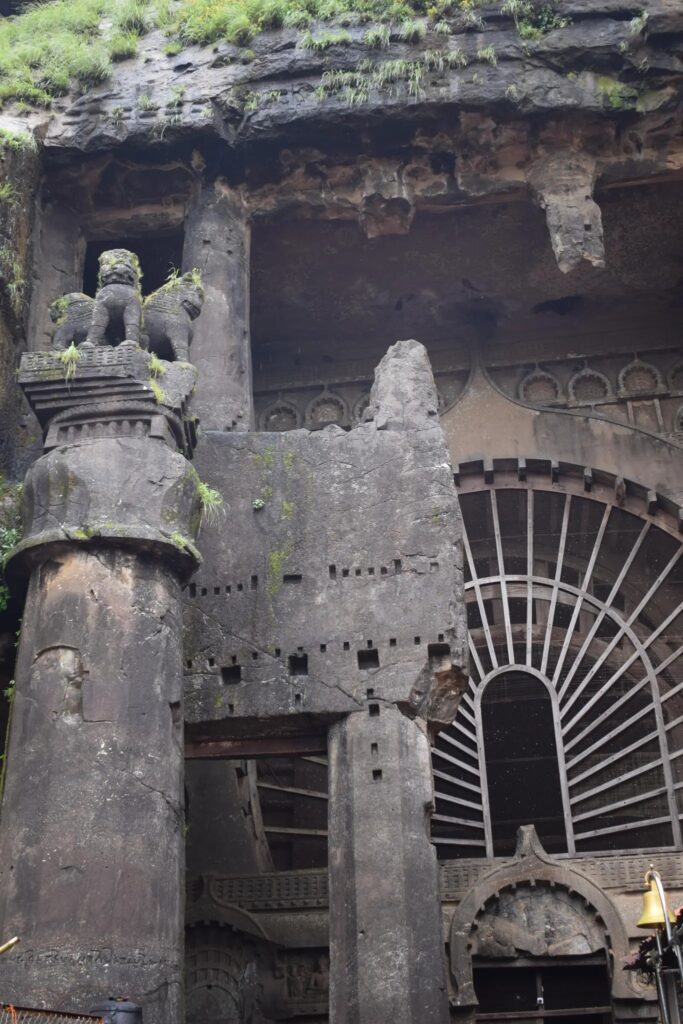
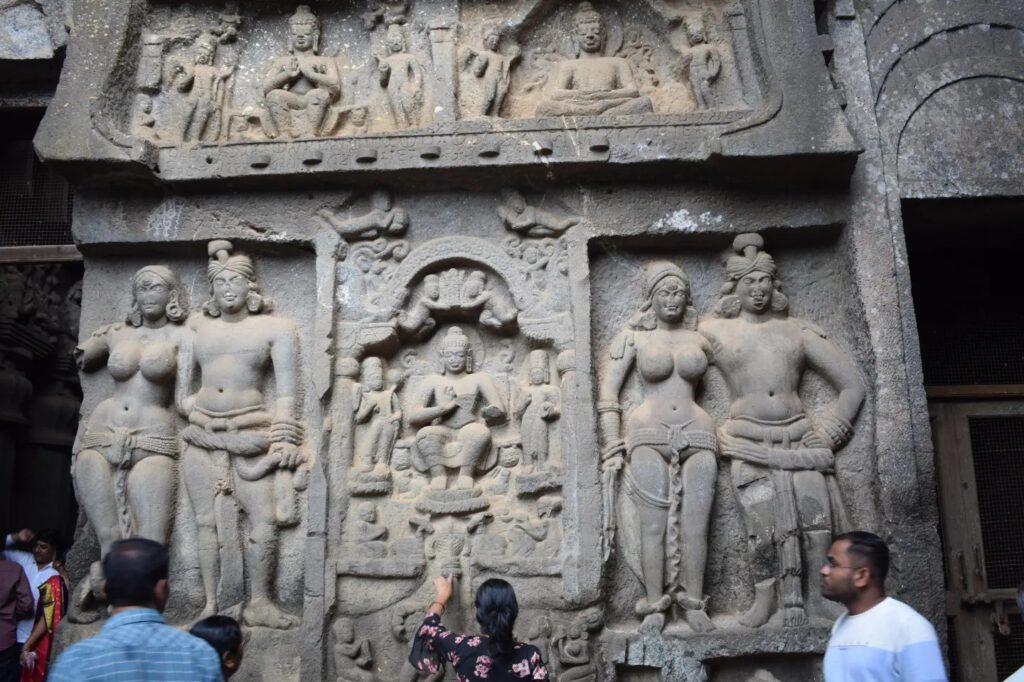

Karla Caves are a significant ancient Buddhist rock-cut cave complex near Lonavala, Maharashtra, dating from around the 2nd century BCE to the 5th–6th century CE���.
Built close to a major trade route, they reflect both religious practice and the patronage of rulers, traders, and local communities��.
Key features:The main highlight is the Great Chaitya Hall (Cave 8), the largest and best-preserved ancient Buddhist prayer hall in India, notable for its vaulted, barrel-shaped ceiling, ornate pillars with animal carvings, and a central stupa����.
Its impressive facade features a large horseshoe-shaped arch, and the entrance is marked by a tall pillar crowned with four lions and a temple dedicated to the goddess Ekvira��.
There are 16 caves in total, including chaityas (prayer halls) and viharas (monastic cells), which were used for prayer, meditation, and accommodation by monks��.
The caves feature elaborate carvings, sculptures, and inscriptions that document donations from kings, traders, and other patrons���.
Some inscriptions are in Brahmi script, showing the socio-economic ties of the period��.
Karla Caves are renowned for their 2000-year-old wooden beams that survive to this day—a rare feat in ancient Indian architecture�.
The sculptures and ornamentation display both Hinayana and Mahayana Buddhist styles, with artistry comparable to Ajanta and Ellora but on a smaller scale��.
The ASI protects Karla Caves for their historical, cultural, and architectural value�. The site is accessible via a short trek in hilly terrain, surrounded by scenic views of the Sahyadri mountains�.
It remains a popular destination for tourists, history enthusiasts, and pilgrims��.